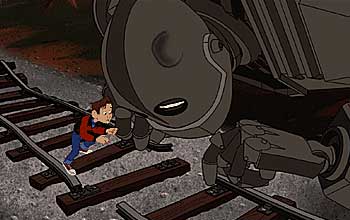
|
Perhaps the differences in character design originate from the main entertainment influences in each respective society. American animation is influenced by film, and in regards to design, structure and storytelling, American animators attempt to produce film. Obviously film is still a big influence on Japanese animation as well, but it's also rooted in the manga tradition, so animators feel comfortable using heightened manga styles to create an aesthetic for the work. X: Yes. And it goes even further. For example, Osamu Tezuka's "Metropolis," which just came out in Japan. He created a manga that was influenced by Fritz Lang's film and, in turn, animators got together to create a film from his manga. What does American character design lack that Japanese character designs do not? X: If Americans don't find anything wrong with American character designs, then there's nothing wrong with the character designs. Obviously we both speak with cultural biases. But, as the Japanese person that I am, I believe that the characters are not welcoming. Making characters beautiful is not a pre-requisite of American animation, but in Japanese animation, most of our characters are cute, or handsome, and that does have an effect on their appeal. We are creating ideals not reflecting reality. That's what I think. What do Americans think? That goes back to my comment about Americans clinging to a live-action aesthetic, character designers trying to make their designs look as real as possible. Japanese animation tends to come from manga and so the designs tend to be more expressive. Broader costumes. Better looking. Is that an accurate observation? X: It's sort of true, but it's a little different. Personally speaking, I like the characters from "Prince of Egypt." The style is strong; the characters look great. In the case of "Iron Giant," there are good character designs and bad character designs. I thought that overall it was a well-animated film, but there is something that's off. It's not necessarily easy to pinpoint by saying, "enlarge the eyes or make the clothing looser." I guess the best way of saying this is "Prince of Egypt" would've been much better if the character designs were done by the person who designed "Iron Giant." Even the things that are on TV at the moment, like "X-Men," if you changed the characters' cheeks a little, or softened the sharp angles to gentle curves, it might be better.
What do you think about American comics? X: I think that American comics are fun and I study them, but I couldn't master them. For example, if a Japanese animator directed an American comic movie, it would lose its essence. You would need someone with the American comic background such as Brian Singer or Tim Burton. I think the way in which each society thinks is different. Although Tim Burton is very similar to the way that Japanese animators think. He has a sensibility that is uniquely his own. The person who is currently doing "Spawn" is just mimicking the original work. He's not really animating the work. But Tim Burton the studies the work and embraces it. |
|||
|
Perfect Blue © Manga Entertainment.
TV Land Logo © TV Land.
X-Men © Marvel Entertainment.
The Nightmare Before Christmas © Tim Burton / Touchstone Pictures / Buena Vista.
The Prince of Egypt © Dreamworks Pictures.
The Iron Giant © Warner Brothers Studio.
|

